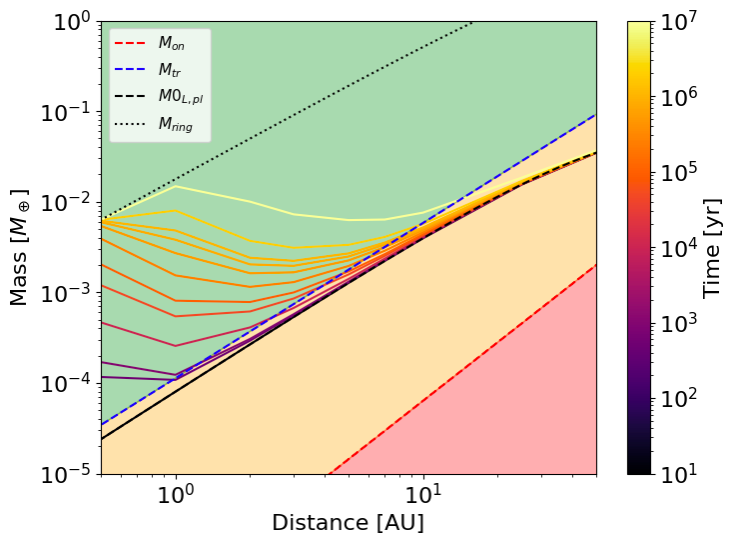Bridging the Gap, From Planetesimals Formation to the Onset of Pebble Accretion: Investigating the Early Growth of Locally Formed Planetesimals
- 1Bern , Physics Institute, Space Research & Planetary Sciences , Switzerland (nicolas.kaufmann@unibe.ch)
- 2Instituto de Astrofísica de La Plata, CCT La Plata-CONICET-UNLP, Paseo del Bosque S/N (1900), La Plata, Argentina.
One of the most promising formation pathways for planetesimals is the concentration of dust via Streaming instability (SI) and the subsequent gravitational collapse into planetesimals. Due to the enhanced dust-to-gas ratio required to trigger the formation via gravitational collapse, the localized formation of a narrow ring of planetesimals is considered in multiple previous studies [3,4]. The subsequent growth of these planetesimals is dominated by mutual collisions up to sizes where they accrete pebbles efficiently. As the timing of core assembly is crucial to the formation of giant planets, understanding the growth of the planetesimals is vital for our understanding of planet formation.
To investigate this scenario, we simulate the formation of the seed of pebble accretion from a filament of planetesimals formed via gravitational collapse. To consistently simulate this early stage of planet formation, we utilize an adapted version of the “Bern model” [1,2]. We track the growth of the largest planetesimal whose initial size is dictated by the initial mass function from Streaming instability simulations [5] from a filament of planetesimals described by a 1D Eulerian disk. Our model newly includes the consideration of multiple important effects that have been neglected or simplified in previous studies: Namely, the viscous spreading of the planetesimals, fragmentation due to the mutual collisions, pebble accretion onto the planetesimals and an improved calculation of the random velocities of the planetesimals which is vital for this stage of planet formation.

In Figure 1. We can see the mass of the largest body in the filament at different times for different locations of the initial planetesimal ring (solid lines). The red dashed line refers to the onset mass of pebble accretion and the blue dashed line to the transition mass [6] above which pebble accretion becomes efficient. The black lines refer to the initial mass of the largest planetesimal (dashed) and the total mass of the ring (dotted). As we can see the growth of the largest body is strongly delayed in the outer disk making it challenging to form the seed of pebble accretion in time to form giant planets. Note that in these simulations we neglected the accretion of pebbles onto the planetesimals and the fragmentation of the planetesimals and are therefore a very conservative estimate for the mass growth of the largest planetesimal.
In conclusion, the formation of a body large enough to accrete pebbles efficiently from a Ring of locally formed planetesimals proves challenging at large separations and is very sensitive to multiple parameters like the stellar mass and the diffusive widening of the filament due to mutual gravitational stirring.
References:
[1] Emsenhuber, A., Mordasini, C., Burn, R., et al. 2021, A&A, 656, A69
[2] Kaufmann, N. & Alibert, Y. 2023, A&A, 676, A46
[3] Lorek, S. & Johansen, A. 2022, A&A, 666, A108
[4] Liu, B., Ormel, C. W., & Johansen, A. 2019, A& A, 624, A114
[5] Schäfer, U., Yang, C.-C., & Johansen, A. 2017, A&A, 59, A69
[6] Ormel, C. W. 2017, in Astrophysics and Space Science Library, ed. M. Pessah & O. Gressel, Vol. 445, 197
How to cite: Kaufmann, N., Alibert, Y., Guilera, O., and Sebastian, I.: Bridging the Gap, From Planetesimals Formation to the Onset of Pebble Accretion: Investigating the Early Growth of Locally Formed Planetesimals, Europlanet Science Congress 2024, Berlin, Germany, 8–13 Sep 2024, EPSC2024-997, https://doi.org/10.5194/epsc2024-997, 2024.